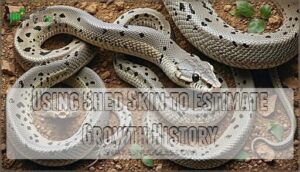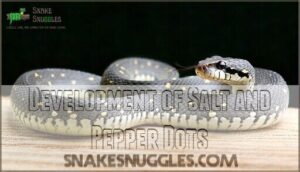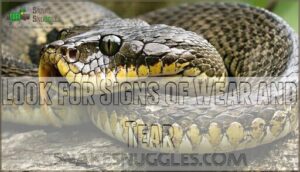This site is supported by our readers. We may earn a commission, at no cost to you, if you purchase through links.

Look at the snake’s size relative to its species, since young snakes grow rapidly and often double their hatchling size within their first year.
Check shedding frequency—younger snakes shed more often to accommodate growth, while older snakes have thicker, more rigid shed skin.
Notice color changes, as many species develop salt-and-pepper dots or faded patterns with age.
Watch for physical signs like increased body girth, visible spine definition, and fatty deposits around the vent area in mature snakes.
Behavioral changes matter too—older snakes typically show decreased activity levels and altered feeding patterns.
Each species ages differently, making accurate estimation challenging without knowing these specific patterns and environmental factors that influence development, including physical signs and behavioral changes.
It is crucial to consider multiple physical and behavioral indicators to estimate the age of a snake accurately.
Table Of Contents
- Key Takeaways
- Observe Snake Size and Growth Patterns
- Examine Shedding Frequency and Skin Quality
- Assess Coloration and Pattern Changes
- Evaluate Physical Features and Body Proportions
- Analyze Behavioral Changes and Activity Levels
- Consider Reproductive Maturity and History
- Look for Signs of Wear and Tear
- Identify Species-Specific Aging Characteristics
- Utilize Professional Expertise and Records
- Combine Multiple Indicators for Accurate Assessment
- Frequently Asked Questions (FAQs)
- How do you tell a snake’s age?
- How old do Snakes get?
- Can a rattlesnake tell its age?
- How do you know if a king snake is old?
- How do you know if a garter snake is old?
- How do you know if an albino snake is old?
- How can you determine the age of a snake?
- How can you accurately age a snake?
- How do you gauge a snake’s age?
- Is It Possible to Determine the Exact Age of a Snake?
- Conclusion
Key Takeaways
- You’ll need to examine multiple indicators together – size, shedding frequency, color changes, and behavior patterns – since no single factor provides accurate age estimates due to species variation and environmental influences.
- Young snakes shed more frequently and grow rapidly – juveniles often double their size within the first year and shed every few weeks, while adults shed only 2-4 times annually with stabilized growth rates.
- Color and pattern changes reveal aging – vibrant juvenile colors gradually fade or darken with age, and many species develop salt-and-pepper dots or lose pattern symmetry as they mature.
- Behavioral shifts indicate advancing age – older snakes show decreased activity levels, reduced exploration, altered feeding patterns, and increased tolerance to handling compared to energetic juveniles.
Observe Snake Size and Growth Patterns
You’ll notice that a snake’s size can tell you a lot about its age, since young snakes grow quickly and add inches almost overnight.
Don’t forget that growth rates and final size vary widely by species, so a tape measure alone won’t reveal every snake’s birthday, which is why considering species is important.
Rapid Growth in Early Years
Snake growth-spurts during the first year are remarkable to observe! Juvenile snakes often double their hatchling size within twelve months due to:
- High metabolic rates driving constant energy needs
- Frequent feeding schedules supporting rapid development
- Early shedding cycles accommodating size increases
- Optimal juvenile diet providing essential growth nutrients
- Species-specific growth patterns varying by genetic factors
This rapid growth phase makes first year measurements essential for snake age estimation.
Continued Growth Throughout Life
Unlike many animals that stop growing at maturity, snakes continue growing throughout their entire lifespan.
This continued growth creates a valuable window into snake age determination. Growth rates slow substantially after reaching adulthood, but the relationship between size and age remains measurable.
Environmental impact from temperature, humidity, and food availability directly affects these snake growth rates.
Species differences mean a five-year-old python shows different size milestones than a similarly aged garter snake, making species-specific knowledge vital for accurate age assessment.
Size Variability Among Species
Size variability among snake species creates significant challenges when estimating age through length measurements.
Carpet pythons demonstrate extreme size variation, with females potentially reaching twice the length of males due to their mating systems.
Geographic location and habitat influence also affect growth rates within species.
A three-foot snake species like a ball python might be mature, while the same length represents a juvenile in larger species.
This size variability means you must know the specific species and sex before using length as an age indicator, making snake size variation a complex but essential factor.
Environmental Factors Affecting Growth
Environmental factors shape growth trajectories in complex ways.
Temperature effects directly influence metabolic rates, while habitat quality determines resource availability and stress levels.
Food availability creates nutritional constraints that impact development speed.
Humidity levels affect shedding frequency and overall health.
Consider these environmental influences on snake growth patterns:
- Temperature fluctuations that slow metabolism during cooler periods
- Seasonal changes creating cyclical growth spurts and dormancy phases
- Habitat degradation limiting prey density and shelter options
- Captive conditions providing consistent resources but reducing natural behaviors
These environmental factors create significant variation in growth rates between wild and captive populations, making precise age estimation challenging without considering housing conditions.
Relationship Between Size and Age
Understanding the relationship between a snake’s size and age requires recognizing that growth patterns vary markedly across species.
While younger snakes typically grow rapidly during their first years, the size correlation isn’t always straightforward.
Species variation plays a major role—some snakes reach maturity indicators at smaller sizes, while others continue growing throughout their lives.
Environmental impact affects these growth patterns, making snake size charts useful but not definitive.
When examining snake length and snake weight, consider that a large snake isn’t necessarily old, and growth rate differences between individuals can be substantial, even within the same species.
Examine Shedding Frequency and Skin Quality
Shedding frequency provides one of the most reliable indicators for estimating snake age, as young snakes shed their skin much more frequently than adults to accommodate rapid growth.
You’ll notice distinct changes in both the texture and thickness of shed skins as snakes mature, with juvenile sheds appearing thinner and more elastic compared to the thicker, more rigid adult versions, which is a key factor in understanding snake development and shedding frequency.
Higher Shedding Frequency in Young Snakes
Young snakes experience rapid-fire ecdysis cycles, shedding every few weeks during their first year to accommodate explosive growth.
Explosive growth stages reveal nature’s urgency in young serpents—each shed marks weeks, not months
Juvenile ecdysis occurs 10-12 times annually, while embryonic shed happens within days of hatching.
You’ll notice shedding intervals dramatically decrease as snakes mature – adults shed only 2-4 times yearly.
Track these higher shedding frequency patterns in a shed journal to establish reliable snake age indicators and monitor snake shedding patterns effectively.
Changes in Shed Skin Texture
Shed skin texture evolves as snakes mature, offering valuable clues for age determination.
Young snakes produce thin, elastic, transparent sheds with smooth surfaces and intact scale detail.
Shed thickness increases with age as keratin layers accumulate through repeated molting cycles.
Older snakes display rougher, more opaque sheds with reduced skin elasticity and frayed scale margins.
This textural progression from supple juvenile sheds to coarse adult ones provides reliable aging indicators when examining snake shedding patterns.
Abnormal shedding, or dysecdysis, can also provide clues about a snake’s health and age.
Shedding Patterns Across Different Species
Snake species’ shedding patterns reveal age-related secrets through distinct characteristics.
Different species exhibit unique ecdysis process variations that help determine maturity levels.
Here’s how shedding patterns vary across snake species:
- Rat snakes demonstrate increased shed frequency during rapid juvenile growth phases
- King snakes and milk snakes produce remarkably smooth, intact shed skins
- Garter snakes often shed in fragmented sections rather than complete pieces
- Python species show thicker skin texture in adult sheds compared to juveniles
Species-specific variations in snake shedding provide valuable shed analysis data. Snake scales’ condition and shed frequency patterns serve as reliable indicators. Documenting these shedding patterns helps track developmental stages across different snake species effectively.
Environmental Influences on Shedding
Environmental factors shape snake shedding like invisible conductors orchestrating a scale symphony.
Temperature and humidity levels directly control shedding frequency, while habitat conditions and water availability create the backdrop for healthy skin renewal.
Key environmental influences include:
- Temperature Impact – Warmer temperatures accelerate metabolic processes and increase shedding frequency
- Humidity Levels – Higher moisture content softens old skin, making removal easier and more complete
- Seasonal Changes – Natural cycles trigger hormonal shifts that influence shedding patterns throughout the year
Your snake’s habitat type determines baseline environmental factors, but you can fine-tune conditions to support proper skin quality.
Maintaining ideal conditions can prevent common shedding problems like stuck shed.
Consistent water availability guarantees adequate hydration for smooth shedding, while environmental factors work together to establish predictable shedding patterns that help estimate age.
Using Shed Skin to Estimate Growth History
Collected shed skins reveal your snake’s growth trajectory like pages in a diary.
Each shed tells a story of growth, marking milestones in your serpent’s silent journey through time
Each shed size documents developmental milestones, while scale patterns show increasing complexity as snakes mature.
Skin elasticity decreases with age—juvenile sheds stretch easily, adult versions feel thicker and more rigid.
Environmental effects influence texture quality, but consistent shedding patterns help establish reliable growth timelines for accurate age estimation.
Assess Coloration and Pattern Changes
You’ll notice your snake’s coloration and patterns change as it ages, with bright juvenile colors gradually fading or darkening over time.
These visual transformations, along with the development of unique markings like salt-and-pepper spots, provide reliable clues about your snake’s approximate age when combined with other assessment methods, utilizing reliable methods.
Fading or Darkening of Colors With Age
Color changes serve as reliable snake age markers.
Color fading and pigment alterations occur naturally as snakes mature, with vibrant juvenile hues gradually dulling over time.
Pattern asymmetry also develops, making once-perfect designs irregular.
These snake coloration shifts vary substantially between species due to genetic influence.
Some species darken dramatically, while others lighten considerably.
Observing these color changes alongside other aging indicators provides valuable insights into your snake’s approximate age and maturity level.
Development of Salt and Pepper Dots
Beyond simple color fading, aging snakes develop distinctive salt and pepper dots across their scales—a reliable snake aging indicator.
These small, contrasting speckles emerge through natural scale pigmentation changes and genetic influence over time.
Pattern symmetry gradually shifts as spot development occurs, creating unique coloration signatures.
Even albino variations display this aging phenomenon, though manifestations differ from typical snake appearance patterns:
- Dots appear randomly across body sections
- Concentration increases with advanced age
- Size and density vary between individuals
- Distribution follows species-specific patterns
Species-Specific Color Changes
Snake species display dramatic color transformations throughout their lives.
Tropical pythons shift from vibrant yellow or red juveniles to emerald green adults.
Black rat snakes lose their blotched patterns, becoming uniformly dark by maturity.
Albino markings yellow with age due to pigment changes.
These species-specific color changes reflect genetic influence and environmental adaptation, making color fading and pattern symmetry loss valuable indicators for determining snake age across different snake species.
This change, known as ontogenetic color change, is linked to shifts in diet and habitat.
Genetic Factors in Color Variation
When estimating snake age through color changes, genetic factors substantially influence what you’ll observe. Gene expression determines base coloration patterns, while mutation effects can create unexpected morphs that deviate from typical aging indicators.
Understanding these genetic influences helps you interpret color variations more accurately:
- Selective breeding programs often enhance or suppress certain color traits, affecting natural aging patterns
- Hybridization impact between species can produce offspring with unpredictable color inheritance and aging characteristics
- Color heritability varies dramatically between species, making some genetic lines more reliable age indicators than others
Snake color and pattern genetics operate independently of age-related changes. Species-specific color changes may appear earlier or later depending on individual genetic makeup, so you’ll need to account for these hereditary factors when evaluating coloration as an aging marker.
Albino Snake Aging Indicators
Albino snakes present unique snake aging indicators that differ from their normally pigmented counterparts.
Color fading becomes particularly evident as these pale beauties mature, with vibrant yellows often shifting to duller, mustard-like tones over time.
Fatty deposits accumulate around the hip area in older specimens, creating visible bulges beneath translucent skin.
Scale changes manifest as rougher texture and reduced flexibility with age.
Watch for unique markings like subtle pattern loss where faint designs become increasingly difficult to detect.
These albino snake aging indicators require careful observation since traditional snake age estimation methods rely heavily on pigmentation changes that aren’t applicable to albino specimens.
Evaluate Physical Features and Body Proportions
As snakes mature, their body proportions shift in subtle but measurable ways that provide valuable clues to their age.
You’ll notice changes in head size relative to body length, muscle tone distribution, and overall body composition that become more pronounced with advancing years, which can be considered complete concepts for understanding snake maturity, and observing these changes can help in determining the age.
Head Width to Body Ratio
When examining head width to body ratio, you’re looking at one of the more reliable morphological changes that occur during snake age determination.
Juvenile proportions typically show a relatively narrow head compared to body thickness, while adult ratios demonstrate progressive head widening as snakes mature.
Species comparison reveals significant variation in head development patterns.
Captive influence can accelerate or alter natural growth rates, affecting measurement accuracy.
Consider these key indicators:
- Head appears disproportionately small in rapidly growing juveniles
- Gradual jaw muscle development creates wider appearance in adults
- Eye positioning shifts slightly as skull bones mature and expand
- Neck definition becomes more pronounced with age and muscle development
- Species-specific variations require knowledge of normal adult proportions
Remember that snake age estimation methods using head measurements work best when combined with other snake morphological changes indicators.
These changes can also be influenced by the snake’s habitat adaptations.
Changes in Body Girth and Muscle Tone
Beyond head proportions, your snake’s body girth and muscle tone reveal important aging clues.
Young snakes display taut, well-defined muscle definition with slender profiles. As they mature, girth increase becomes apparent, especially in well-fed specimens. Adult snakes develop broader midsections while maintaining healthy muscle tone.
However, distinguishing between natural growth and health-related changes requires careful observation.
| Age Stage | Body Characteristics | Muscle Definition | Typical Girth |
|---|---|---|---|
| Juvenile | Slender, taut profile | Sharp, visible muscles | Narrow, uniform |
| Subadult | Moderate thickening | Good tone, less defined | Gradually widening |
| Adult | Robust, rounded | Solid but softer | Noticeably broader |
| Senior | Variable condition | May show decline | Often thickest |
Development of Fatty Deposits
Beyond muscle changes, you’ll notice fatty deposits developing around your snake’s "hips" – the area near the vent.
These bulges are particularly common in captive snakes with consistent feeding schedules. Diet influence plays a major role, as overfeeding accelerates deposit formation.
While normal in aging snakes, excessive deposits signal health implications requiring dietary adjustments. Albino snakes may show more pronounced fatty accumulation.
These snake aging signs serve as reliable age estimation techniques when combined with other snake health indicators for thorough assessment.
Spine Visibility in Older Snakes
As aging snakes navigate their later years, spine visibility becomes increasingly apparent through natural changes in muscle loss and body composition.
You’ll observe the vertebrae prominence becoming more defined as skin elasticity decreases and hydration levels fluctuate.
These snake aging signs manifest as:
- Visible ridge formation along the dorsal surface
- Pronounced vertebrae outline beneath the skin
- Reduced muscle padding around the spinal column
This overall body condition assessment helps determine snake age, though proper nutrition can minimize these effects.
The spine visibility serves as a reliable snake health indicator when combined with other aging markers.
Species-Specific Physical Aging Signs
While spine visibility offers aging clues, each snake species displays distinct physical markers that reveal their years.
Garter snakes develop rougher lateral scales and lose skin gloss after seven years. Rattlesnakes accumulate rattle segments with each shed, though breakage complicates accurate counts. Boas and pythons show flattened body shapes, reduced dorsal muscle mass, and loose skin in seniors.
Pattern asymmetry and color fading intensify with age across species. Venomous snakes like copperheads exhibit increased scale texture roughness and darker pigmentation patches past reproductive maturity.
These species-specific aging characteristics help you pinpoint age ranges when combined with body girth changes and overall condition assessment for reliable snake age identification.
Analyze Behavioral Changes and Activity Levels
As your snake ages, you’ll notice distinct behavioral shifts that reveal important clues about its life stage.
Older snakes typically become less active and show marked changes in feeding habits, exploration patterns, and responses to handling, which are critical indicators of their life stage.
Decreased Activity in Older Snakes
Activity-pattern shifts reveal essential snake aging indicators through observable behavioral modifications.
As snakes age, energy conservation becomes paramount, leading to substantially reduced daily movement and exploration patterns.
- Extended resting periods – Older snakes spend 70-80% more time motionless compared to juveniles
- Diminished environmental exploration – Reduced investigation of new territories or hiding spots
- Slower stimulus responses – Delayed reactions to movement, sounds, or temperature changes
- Decreased basking frequency – Less time spent actively thermoregulating under heat sources
Seasonal activity patterns become more pronounced with age, as older snakes exhibit greater sensitivity to temperature fluctuations.
This behavioral shift reflects metabolic slowdown and represents a reliable snake aging marker when combined with physical assessments.
Changes in Feeding Habits
As your snake ages, you’ll observe several distinct changes in feeding habits that reflect declining metabolic needs and hunting skills.
Feeding frequency decreases substantially, with older snakes requiring meals less often than juveniles.
Prey size preferences shift toward smaller options as digestive efficiency and jaw flexibility decline.
These dietary shifts serve as reliable indicators of snake age, alongside reduced appetite and longer intervals between meals, making behavioral changes essential markers for age assessment.
Alterations in Exploration Behavior
Beyond feeding patterns, reduced curiosity becomes a telltale sign of aging in snakes. Environmental interaction shifts dramatically as reptiles mature, offering valuable insights for snake age determination through behavioral changes.
Novelty response patterns reveal three distinct aging phases:
- Juvenile snakes actively investigate new objects and spaces within their habitat
- Adult snakes display more selective exploration based on habitat familiarity
- Senior snakes show diminished interest in environmental changes due to sensory decline
Observing alterations in exploration behavior provides reliable markers for snake behavior analysis and aging assessment.
Response to Handling and Socialization
Older snakes often develop specific handling tolerance patterns that reveal important behavior shift clues for snake age assessment.
Young snakes typically show defensive stress indicators like rapid movements or striking, while mature animals demonstrate calmer response to handling.
Temperament shifts become more predictable with age, as captivity effects influence socialization success.
Socialization benefits include reduced handling stress, making age-related behavioral patterns clearer during routine care interactions.
Seasonal Behavioral Variations
Since temperatures fluctuate throughout the year, you’ll notice distinct activity cycles in snakes that can help determine snake age.
Understanding these seasonal behavioral variations provides valuable insights into snake behavior and supports snake aging assessments.
Key patterns to observe include:
- Brumation habits during winter months when older snakes show extended dormancy periods
- Feeding patterns that shift dramatically between seasons, with juveniles maintaining more consistent appetites
- Mating season behaviors where mature snakes display territorial and reproductive activities absent in younger specimens
These social changes throughout the year offer reliable markers for snake age determination when combined with other assessment methods.
Consider Reproductive Maturity and History
Reproductive maturity serves as a critical biological marker that can help you estimate your snake’s age range with greater accuracy.
Understanding breeding behaviors, physical development of reproductive organs, and species-specific maturation timelines provides valuable clues about whether you’re observing a juvenile, subadult, or fully mature snake.
Age of Sexual Maturity by Species
Sexual maturity varies dramatically across snake species.
Ball pythons reach breeding age at 1-2 years for males, 2-3 years for females, while black rat snakes may wait 7-10 years.
Garter snakes mature around 2 years, but Burmese pythons take 4-5 years.
Most species achieve reproductive maturity between 18 months and four years, with captive breeding often accelerating this timeline compared to wild populations.
Captive ball pythons can live over twenty years with proper care.
Changes in Reproductive Organs
Through maturation, a snake’s reproductive organs transform dramatically, offering reliable clues about sexual maturity and overall snake age.
These changes in reproductive organs reflect hormonal shifts that directly correlate with snake maturity signs.
Observable transformations include:
- Testicular enlargement and increased sperm production capacity in mature males
- Oviduct thickening and enhanced follicular development in breeding females
- Gradual organ degeneration affecting breeding frequency as snakes age
- Reduced clutch size potential in older reproductive females
- Hormonal shifts causing decreased fertility and reproductive drive over time
Breeding History Indicators
Breeding history provides valuable clues about snake age through documented reproductive patterns.
You’ll find clutch frequency decreases as snakes mature, with younger females producing smaller, less viable eggs.
Fertility decline becomes apparent in aging snakes, showing reduced egg viability and smaller clutch sizes.
Breeding lifespan varies by species, but most snakes show declining reproductive success after reaching middle age.
Hybrid offspring quality can also indicate parental maturity levels, as experienced breeders typically produce healthier young.
Hormonal Changes With Age
Hormonal changes reshape your snake’s physiology as it ages, affecting reproductive cycles and overall health.
These biochemical shifts influence three key areas:
- Growth Hormone production decreases, causing Metabolism Shift and slower tissue repair
- Reproductive Decline alters breeding patterns and Ecdysis Impact on shedding frequency
- Stress Response mechanisms weaken, affecting immune function and recovery rates
Understanding these hormonal changes helps you assess snake maturity beyond simple size measurements.
Impact of Captivity on Reproduction
Captive environments alter your snake’s reproductive health through controlled conditions that differ from wild habitats.
Captivity’s breeding success depends on proper nutrition and temperature regulation, while limited genetic diversity in breeding programs affects long-term viability.
These breeding history indicators help you assess maturity and conservation implications for species preservation efforts.
Look for Signs of Wear and Tear
Physical wear and tear provides clear evidence of a snake’s age, as older animals naturally accumulate scars, damaged scales, and worn teeth over years of normal activity.
You’ll notice these aging indicators by examining the snake’s overall body condition, checking for joint stiffness, and evaluating the quality of its scales and dental structures.
Accumulation of Scars and Injuries
Beyond reproductive changes, physical battle scars reveal a snake’s survival history.
Older snakes accumulate more scar tissue and scale damage from territorial disputes, predator encounters, and environmental hazards.
These injuries create permanent markers that help estimate age through their healing process and injury location.
- Bite marks from failed predation attempts or mating conflicts
- Scale damage patterns from rough terrain navigation over time
- Scar tissue formation indicating multiple survival episodes
- Injury location revealing behavioral and habitat stress points
Scale Damage and Regeneration
Scale damage reveals important aging patterns through regeneration limits and scar tissue formation.
While scales typically regenerate during shedding, deeper injuries create permanent injury patterns that persist across multiple sheds.
Scale morphology changes with shedding imperfections in older snakes, showing accumulated damage over time.
These permanent marks help estimate snake age through scale damage analysis.
Tooth and Fang Wear
While tooth and fang wear naturally increases with your snake’s age, this dental deterioration serves as a reliable indicator for age estimation.
Venomous species show particularly noticeable fang replacement patterns, with older snakes cycling through fangs every 3-6 months versus younger snakes replacing them monthly. Enamel degradation becomes visible through microscopic examination, revealing microcracking and opacity.
Diet impact substantially affects wear patterns – snakes consuming hard-boned prey experience 2.5 times more dental attrition than those eating soft-bodied animals. Reduced bite force and hunting efficiency often accompany these age-related changes.
- Blunted or grooved fangs
- Discolored or yellowed teeth
- Difficulty capturing and consuming prey
- Reduced bite force and hunting success
- Changes in feeding behavior and preferences
Joint and Spine Flexibility
Older snakes show decreased joint stiffness and spinal rigidity as cartilage deteriorates.
You’ll notice reduced movement range and flexibility decline when handling aged specimens.
Their vertebrae condition becomes less supple, making coiling motions slower.
This snake skeletal growth pattern helps with age estimation – younger snakes bend like rubber bands while older ones move more deliberately, reflecting natural snake aging processes.
Overall Body Condition Assessment
Carefully evaluating overall body condition provides essential insights into snake age and health status.
Assess these key indicators systematically:
- Muscle tone: Younger snakes display firm, well-developed musculature, while older specimens often show decreased muscle definition and increased skin laxity
- Hydration levels: Examine skin elasticity and body fat distribution, as dehydration becomes more common with advancing age
- Skin integrity: Look for accumulated scars, scale irregularities, and signs of injury assessment that indicate life experience and potential aging.
Observing healthy snake appearance can also be a key indicator.
Identify Species-Specific Aging Characteristics
Different snake species exhibit unique aging patterns that you can learn to recognize with practice.
Understanding these species-specific characteristics helps you make more accurate age estimates when combined with general aging indicators, which can lead to a better comprehension of aging patterns.
Garter Snake Aging Indicators
Garter snakes show distinct garter snake aging indicators through scale texture changes and pattern symmetry loss.
Young garters display vibrant stripes with smooth scales, while older specimens develop rougher textures and faded patterns.
Head ratio increases slightly with age, and spine visibility becomes more pronounced in seniors.
These snake aging indicators help determine approximate age ranges effectively.
Rattlesnake Rattle Growth Patterns
While counting rattle segments might seem straightforward for age estimation, you’ll find this method unreliable.
Rattle segments don’t correspond to years since rattlesnakes shed multiple times annually, creating new segments with each shed.
Rattle wear, breakage, and anomalies further complicate accurate snake age determination, making rattle composition analysis insufficient for precise reptile aging methods.
Boa and Python Aging Signs
Boas and pythons display distinct snake aging signs through scale morphology and pattern complexity changes.
You’ll notice colors fade and develop salt-and-pepper speckling as these giants mature.
Eye changes become apparent in older specimens, while muscular atrophy affects body tone.
Skeletal analysis reveals joint stiffness, and captive boa and python aging signs differ from wild counterparts due to consistent care affecting reptile aging methods.
Venomous Snake Age Estimation Techniques
While boas and pythons show gradual changes, venomous species require specialized approaches for accurate snake age estimation.
Professional expertise becomes invaluable when analyzing these dangerous specimens safely.
- Venom analysis reveals age-related shifts in toxin potency, with juveniles producing different protein compositions than adults
- Fang morphology changes subtly over time, showing wear patterns and size variations in mature specimens
- Rattlesnake rattle growth patterns provide segmentation clues, though breakage limits long-term accuracy
- Venom yield typically increases with body size and age in most species
- Snake scale analysis shows cumulative damage and thickening in older venomous snakes
Utilize Professional Expertise and Records
When visual assessment reaches its limits, professional expertise becomes your most reliable resource for accurate age determination.
Experienced herpetologists and reputable breeders possess specialized knowledge and comparative databases that can provide precise age estimates when combined with detailed records.
Consulting Herpetologists and Breeders
When species-specific aging characteristics aren’t enough, you’ll want Expert Consultation from professionals who’ve spent years studying snake behavior and genetics.
Herpetologists and snake breeders offer invaluable Species Knowledge, reviewing Breeding Records and Genetic Lineage to provide accurate age assessments through their extensive professional expertise.
Many look to find herpetologist snake products for their research.
| Professional Type | Expertise Area | Assessment Method |
|---|---|---|
| Herpetologists | Species biology | Comparative analysis |
| Snake breeders | Genetic lineage | Breeding records review |
| Veterinarians | Health history | Physical examination |
| Researchers | Population data | Statistical modeling |
Importance of Accurate Birth Records
Accurate birth records serve as the foundation for reliable snake age determination and scientific research.
Professional breeders and researchers maintain detailed documentation that tracks each snake’s journey from hatchling identification through genetic lineage verification.
These records support breeding management programs and conservation efforts while enabling precise research applications.
Documentation eliminates guesswork in snake age assessment, providing the accuracy needed for:
- Veterinary care and health monitoring protocols
- Breeding program optimization and genetic tracking
- Conservation research and population studies
- Scientific studies requiring known-age specimens
Using Comparative Analysis With Known-Age Snakes
While accurate birth records provide the gold standard for snake age approximation, comparative analysis with known-age snakes offers valuable verification.
By examining growth comparisons, pattern development, and shedding frequency against documented specimens, you’ll establish reliable behavioral benchmarks for age estimation.
| Age Range | Physical Characteristics | Key Indicators |
|---|---|---|
| Hatchling (0-1 year) | Rapid size increases, frequent shedding | Bright patterns, high activity |
| Juvenile (1-3 years) | Steady growth, moderate shedding | Pattern clarity, exploration behavior |
| Subadult (3-5 years) | Slowing growth, reduced shedding | Subtle color changes, territorial behavior |
| Adult (5+ years) | Minimal size change, infrequent shedding | Faded patterns, decreased activity |
| Senior (15+ years) | Stable size, very low shedding | Noticeably dulled colors, limited movement |
The age ranges, including Hatchling, Juvenile, Subadult, Adult, and Senior, are distinguished by distinct physical characteristics and key indicators, facilitating a more precise age estimation.
Limitations of Age Estimation Methods
Even experienced herpetologists face snake age estimation challenges that can’t be overlooked.
Data accuracy depends heavily on species variation, as each snake ages differently. Environmental impact from captivity effects can skew physical markers, while ethical concerns limit invasive testing methods.
Consider these key limitations:
- Individual genetics – Two snakes from identical conditions may age at completely different rates
- Incomplete records – Missing birth data makes comparison-based methods nearly impossible to verify
- Health status – Illness or injury can dramatically alter typical aging patterns and physical development
Captivity can also influence a snake’s growth and shedding.
Emerging Technologies in Snake Age Determination
Revolutionary genetic markers and AI patterning are transforming snake age determination.
Skeletochronology and scale clipping analysis provide precise growth data, while isotope analysis reveals dietary history.
Micro CT-scanning, ultrasound imaging, and biologging sensors offer non-invasive monitoring.
These emerging technologies deliver unprecedented accuracy, making traditional guesswork obsolete for serious herpetologists.
Combine Multiple Indicators for Accurate Assessment
You can’t rely on a single clue when determining a snake’s age since growth rates, color changes, and behavior patterns vary substantially between individual animals and species.
Successful age estimation requires combining multiple physical indicators like size, shedding frequency, and pattern clarity with behavioral observations and environmental considerations to build a thorough picture of the snake’s life stage.
This approach allows for a more accurate assessment, as it takes into account the various factors that influence a snake’s development, including physical indicators.
Integrating Physical and Behavioral Clues
Professional snake age determination requires integrating physical and behavioral clues for accurate assessment.
Your integrated analysis should combine multiple indicators rather than relying on single characteristics.
When examining snake age determination, observe these key correlations:
- Size-behavior patterns: Large snakes showing feeding decline often indicate advanced age
- Shedding behavior changes: Decreased frequency paired with activity correlation suggests maturity
- Behavioral consistency: Reduced exploration combined with physical aging signs confirms estimates
This thorough approach enhances age estimation accuracy substantially.
Weighing Environmental and Dietary Factors
Environmental and dietary factors substantially shape snake age factors and growth patterns.
Temperature Effects accelerate or slow development, while Habitat Influence determines prey availability and stress levels.
Dietary Impact from consistent, quality nutrition optimizes growth, whereas poor diet stunts development.
When estimating age, you’ll need to take into account these environmental factors alongside physical indicators for accurate assessment.
Accounting for Individual Variation
While environmental and dietary factors set the stage, individual variation remains the wild card in snake age determination methods.
Every snake’s genetic predisposition influences growth patterns differently, even within identical conditions.
Consider these key variables affecting age estimation:
- Genetic predisposition shapes baseline growth rates and maximum size potential
- Environmental impact from temperature, humidity, and habitat quality varies substantially
- Dietary differences between captive vs wild snakes create substantial variation
- Stress factors from handling, relocation, or health issues alter development
- Individual metabolism creates unique aging signatures despite similar circumstances
Recognizing Limitations in Age Determination
While accounting for individual variation helps refine your estimates, you can’t ignore the inherent variability that makes age determination tricky.
Method accuracy hits walls when species differences and environmental impact create unique aging patterns. Estimating challenges arise because genetic factors influence how quickly patterns fade or colors shift.
Even when you combine multiple indicators, limitations of age estimation methods persist—some snakes age like fine wine, others like milk left in the sun.
Recognizing limitations keeps your expectations realistic and prevents overconfidence in your assessments.
Importance of Regular Monitoring and Documentation
Data-driven insights from consistent snake age records transform guesswork into scientific precision.
You’ll track growth pattern deviations and health trend analysis that reveal aging signatures unique to each species.
Environmental impact tracking through detailed documentation enables long-term studies that advance our understanding of snake biology.
Your thorough snake age documentation becomes invaluable research data.
Frequently Asked Questions (FAQs)
How do you tell a snake’s age?
Picture examining a serpent’s sleek form like reading nature’s growth chart.
You’ll measure length, observe shedding frequency, and note color vibrancy – young snakes shed often with bright patterns, while older ones show faded scales and slower growth.
How old do Snakes get?
Snakes can live surprisingly long lives, with lifespans varying dramatically by species.
Wild snakes typically live 10-25 years, while captive snakes often reach 20-40 years due to veterinary care and consistent food sources, which can significantly impact their lifespan.
Can a rattlesnake tell its age?
Rattlesnakes can’t determine their own age, but you can estimate it by counting rattle segments.
Each shed creates a new segment, though segments break off over time, making older snakes harder to age accurately.
How do you know if a king snake is old?
Determining an aging king snake isn’t straightforward—you’ll notice faded patterns, less symmetrical markings, and duller colors as telltale signs.
Older specimens shed less frequently and show decreased activity levels compared to vibrant juveniles.
How do you know if a garter snake is old?
You’ll notice older garter snakes develop rougher scale texture and faded patterns compared to their vibrant juvenile coloration.
Their feeding frequency decreases, activity levels drop, and they shed less often as growth slows substantially, which is a key aspect of their development as they age and their activity levels change.
How do you know if an albino snake is old?
Like faded photographs losing their vibrant hues, you’ll notice albino snakes develop telltale aging signs.
These signs include unique color fading and fatty deposits around their "hips."
This helps in distinguishing elderly specimens from their younger counterparts.
How can you determine the age of a snake?
You’ll determine a snake’s age by examining its length, weight, and shedding patterns. Young snakes shed frequently and grow rapidly, while adults shed less often with stabilized growth rates.
How can you accurately age a snake?
Age is like a snake’s secret diary written in scales and skin.
You’ll accurately determine age by measuring length, tracking shedding frequency, observing color pattern changes, and noting behavioral shifts combined with species-specific growth benchmarks.
How do you gauge a snake’s age?
You’ll examine multiple physical characteristics to estimate your snake’s age accurately.
Measure length and weight, observe color pattern changes, track shedding frequency, and note behavioral shifts like reduced activity levels in older specimens.
Is It Possible to Determine the Exact Age of a Snake?
You can’t pin down a snake’s exact age like clockwork.
Scientists use multiple indicators—length, weight, shedding patterns, and color changes—but these provide estimates rather than precise ages due to species variations and environmental factors.
Conclusion
Like a detective piecing together clues from a crime scene, determining how to tell snake age requires careful examination of multiple evidence pieces.
You can’t rely on a single indicator—size alone might mislead you, just as a well-fed juvenile could appear older than a malnourished adult.
By combining physical markers like shedding frequency, coloration changes, and body proportions with behavioral observations, you’ll develop a more accurate picture.
Remember that species variation and environmental factors substantially influence these aging signs, making expert consultation valuable for precise estimates.























